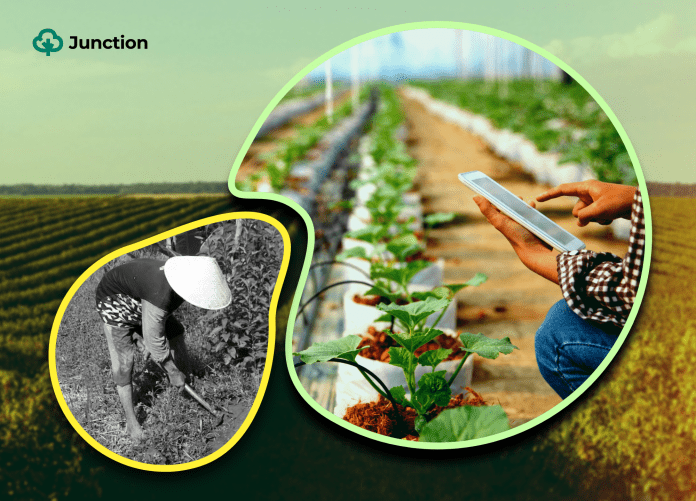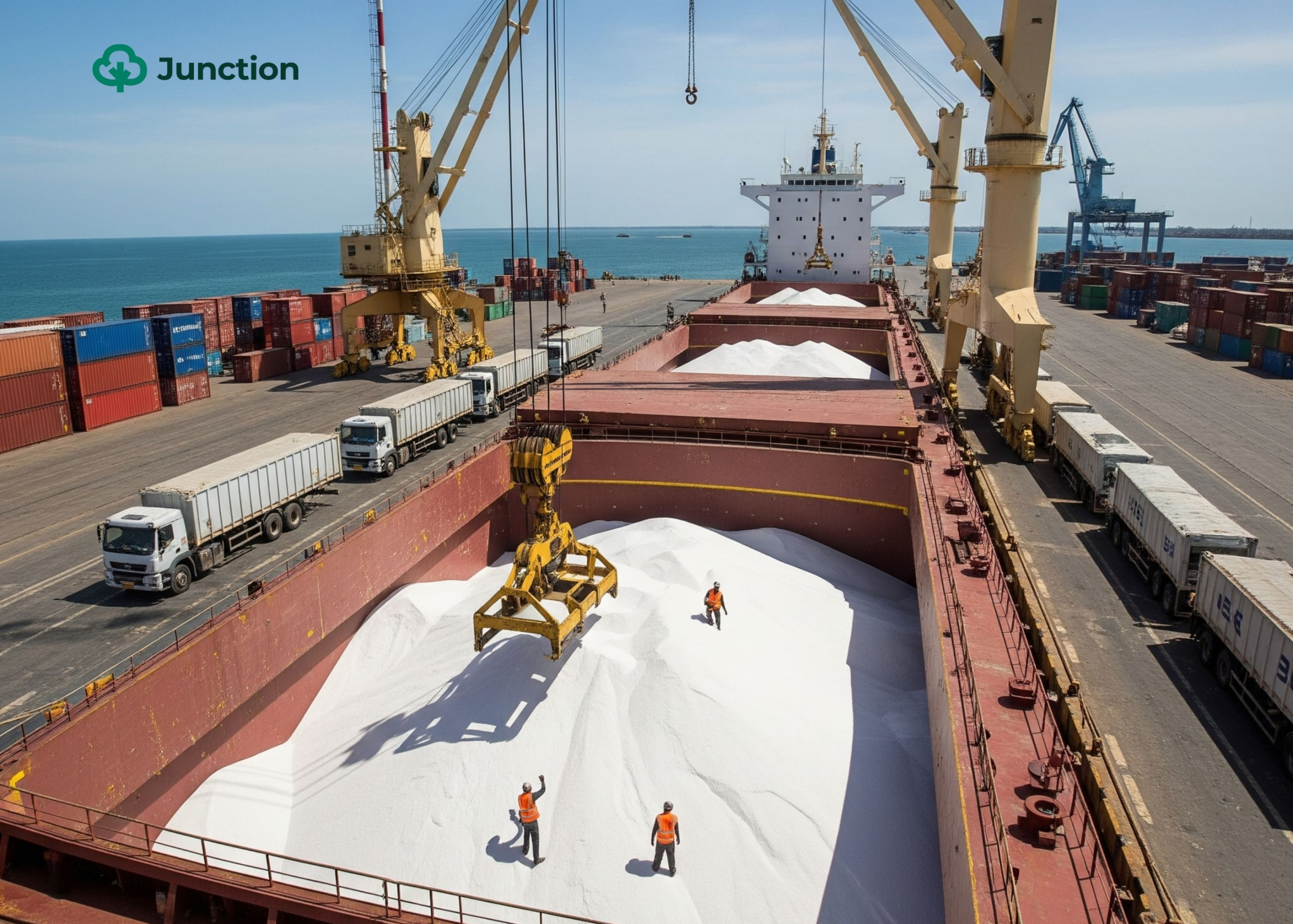Questions answered in this article: - Compared to other countries, why are smallholder farmers in Nigeria unable to drive agriculture change alone? - What is the state of medium holder (or medium-scale) agriculture in Nigeria, and what are its potential benefits? - What can be done to ensure that medium holder farmers in Nigeria attain their full potentials?
Try to paint a picture of the Nigerian farmer in your mind, there is a big chance that your picture consists of a person that is poor, old, ashy, maybe bent over and has a machete in their hands. You will also see them on a small patch of land that they use for subsistence agriculture, and maybe a few scantily clad children and farm animals milling around them.
This is the picture of a Nigerian smallholder farmer that most people outside of farming see and appreciate, one that agricultural policymakers support and unwittingly perpetuate, without a path to grow them. It is the picture agricultural interventions have supported, and unfortunately, 80% of Nigeriaâs agriculture relies on this picture, thereby sustaining the narrative that agriculture is the same as poverty.
Ironically, we encourage young people to study and practice agriculture to end up in this picture. Also, as a nation, we aspire for agricultural dominance with this picture in mind. Suffice to say, the vision will not work.
Definitions widely vary for what is considered smallholder in agriculture per location, practices, techniques, and output. For example, according to the United Nation Conference on Trade and Development (UNCTAD), a 50-hectare farm in Brazil may be considered smallholder; in the USA, a farm with output value as much as $100,000 per annum is considered smallholder, making them economically viable. In Nigeria, smallholder farming takes place on less than 5 hectares with an output of about â¦1.5 million ($2,000).
One can easily see how Nigeria limits smallholder agriculture to subsistence, where the farmer produces to sustain their family and maybe sell some surplus. It also limits their commercial interactions in financial markets, leaving them in a perpetual loop of underproduction, which the standard narrative perpetuates.
Table 1:

An average Nigerian smallholder farmer is about 45 years old and male, according to an Agromall survey, with no more than primary education, and produces on about 2.5 hectares with a yield of around 2 tons per hectare of cereal in one crop cycle annually. He employs traditional practices and hardly subscribes to good and impactful agricultural practices such as mechanisation and digitisation. Efforts to support him do not consider his growth or intentionally place him on a path to evolve into something bigger.
Segmentation and segregation in Nigeriaâs agriculture
Though not official, Nigeriaâs agriculture is largely segmented into two extremes of smallholders and commercial players. These two get most, if not all, mentions, attention, and interventions, as we have seen in the recent input disbursement to farmers under the current administration’s food security emergency plan.Â
Numbering between 25 and 70 million, smallholders contribute over 90% of produce and job output of Nigeriaâs agriculture. They operate in fragmented and suboptimal conditions, with market interactions left at the whims of middlemen that extract significant value from their venture.
It is hard to find a smallholder farmer who has evolved into a commercial farmer. A closer look at government interventions like the Anchor Borrowers Programme (ABP), non-governmental organisationsâ efforts, and even private out-grower schemes point to no deliberate effort to grow smallholdersâ holdings or evolve them into commercial farmers. It seems the country and every other stakeholder unwittingly wants the smallholder to remain smallholders in a world where growth should be natural.Â

There is an argument favouring commercial agriculture in the other extreme as the only way Nigeriaâs agriculture can reach its potential. Proponents believe that big efficiency gains must be scored using tools such as mechanisation on thousands of hectares to get agricultural production to levels that can guarantee food security, and provide other benefits like low prices and export quality produce. Opposing views believe this will jeopardise smallholder agriculture, especially its social dimension, which provides jobs for a large chunk of the population and centres the rural economy.
Though their financing issues are not as amplified as in smallholder agriculture, commercial agriculture is not immune to other structural issues such as bad roads, poor electricity and insecurity that currently plague Nigeria. The impact of these issues on large-scale agriculture is outsized and significant because they happen extensively. Therefore, they wipe out significant investments and value when their risks crystallise, and examples abound. Â
In 2021, bandits sacked a â¦20 billion commercial tomato farm in Kebbi state owned by GB foods â a multinational. In 2022, Olam, another multinational, lost its rice farm valued at over $10 million to floods that were occasioned by the opening of the floodgates of a dam in Cameroon. These losses, and others, have created a situation where food companies recourse to using aggregation models to source produce from smallholder farmers, as they turn away from huge investments in primary production that are at the mercy of a sub-optimal operating environment.

One may be wrongly tempted to believe that only smallholder and commercial large-scale segments contribute to Nigeriaâs agriculture because of the attention they have received. It is instructive to say there is a missing âmiddleâ that may contribute anywhere between 15% and 25% of Nigeriaâs agricultural output at a value of about â¦10.6 trillion, giving the sectorâs worth in 2022. According to a survey, this segment has grown its share of Nigeriaâs agricultural land holding from 7% to 18% in the ten years leading to 2018. It is by far the fastest growing, while taking market shares from smallholder and commercial agriculture.Â
Table 2:

As evidenced by the case of Essien and Oladipo, medium holder agriculture is promising and may hold the key to revitalising and transforming Nigeria agriculture. Players in this segment are big enough to grow efficiently and are nimble enough to weather structural challenges and risks. In countries Like Nigeria and Ghana that have seen consistent growth in agricultural output, medium scale farms contributed a significant portion of the growth while utilising less aggregate land than smallholders.
Why is medium holder agriculture growing?
Major trends of high global food price cycles and the rise of land markets have amplified commercial and economic opportunities in agriculture.
The high food prices cycles of between 2005 and 2008, 2011 and the most recent caused by global inflation and the Russian-Ukraine war in 2022, point investors and stakeholders to the potential for good returns in agriculture. Rapidly growing population further adds to the market opportunities presented to agricultural producers, as more demand is created.
Medium holders have stepped in to bridge the supply gap efficiently and profitably too. The rise of land markets occasioned by reforms in land laws and the deepening commoditisation of rural farmland with models such as outright sale and land leasing have created greater access to agricultural land for cultivation.Â
These factors combine with access to and understanding of best practices, input, technology, and capital to pursue the superior return on investment available in medium holder agriculture.Â
The trend is further fueled by an array of participants who take agriculture as primary and secondary-side âhustleâ options. Younger people, who are educated, adopt best practices and technology, and have a commercial outlook with keen eyes for growth and transformation constitute a good portion of this group. Their success, like the examples in this article, has made more participants take notice and jump on the trend.
The profile of the medium holder elicits hope for agricultural revolution in Nigeria
The medium holder is usually savvy and highly productive, with a focus on sustainable profitability and capital appreciation through efficiency and venture expansion. They also want to make an impact.Â
They are educated, therefore, have an informed worldview and knowledgeable grasp of the practice and business of agriculture. This enables them to appreciate productivity enhancers such as early adoption of new technology and compliance with best and improved agricultural and business practices.Â
They better apply capital and finance, and they are associated with significant farm and non-farm income, while supporting small-scale and large-scale farmers for practice improvement and market access, within their own growth and expansion ambitions.
More than 52% of medium holders in Nigeria move directly from non-farm investment to significant farm holding at medium holder levels-injecting significant capital into agriculture, according to a 2018 survey. The numbers are even higher in countries like Zambia and Kenya, reaching 75%. Thus, showing that people are increasingly taking agriculture as a viable economic option and putting money made from other sectors into agriculture. This underscores why medium holder agriculture is on the rise where substantial undeveloped lands have seen no man-made structures or land modifications-like Nigeria’s about 60 million hectares of uncultivated arable land. It, in turn, contributes to the national efforts of increasing the cultivation of arable land and improving agricultural productivity.Â
Outsized opportunities for agricultural transformation is presented by medium holder farmers
As we have seen here, medium-size farmers have grown their share of cultivated land in Nigeria significantly in recent years. They produce as much as 40% of some countriesâ marketed agricultural produce, even though they cultivate about 23% of land. This shows that growth and efficiency gains mostly reside with medium holders, which further presents the opportunity to transform the agricultural base rapidly.Â
Due to the youthful demography of the medium holder segment, a lot of them have aspirations to grow from farming to integrated agricultural enterprises with eyes on superior return on investment. This demography is well-equipped to understand business, technical practices and what growth requires. Their growth and expansion should translate to the growth and transformation of Nigeriaâs agriculture.Â
Medium holders are the most effective supporters of smallholders for sustained incremental improvement in both practice and business. This is because they share many social and economic ties, and participate in the same rural institutions, therefore have mutually beneficial economic synergies.Â
The real benefit of these synergies is evidenced in such areas as the mechanisation of smallholders, which grew from 3% to 23% where medium holders are present in Tanzania. Another is commercial produce aggregation and off-take from smallholders, which significantly improves where medium holders are present. Â
There are several other adjacent value chain and macro-economic benefits that medium holder agriculture presents, they include improved productivity for food security, export, taxes for reinvestment, general sector equilibrium, rural transformation, and other positive multiplier effects.Â
Optimising medium holder agriculture in Nigeria to realise potential benefits
As Nigeria seeks to leverage opportunities presented by agriculture for its economic development and productive engagement of young people, policymakers and sector stakeholders must take note of the efficiency and effectiveness presented by medium holders agriculturists and use them to accelerate transformation. Key considerations for optimising medium holder agriculture should include the following areas.
Policies and resolutions to support medium holder agriculture in such areas as productivity, tax, applied education, beginner-farmer support, and finance. Mediumholder agriculture must also be the focus segment of flagship agricultural finance interventions and centred on the delivery of agriculture policy that links with youth engagement, smallholder agriculture and commercial agriculture.
Specialised financial services that can support medium holders for growth and transformation into integrated agricultural producers and exporters. This should, at the minimum, entail the ability to extend financing of up to â¦50 million with a growth and transformation outlook, while reducing barriers to access and administration, using capabilities such as digitisation and community.
Linkages to cater to agriculture and other categories that intersect with agriculture, such as markets, manufacturing, and export, particularly in SME segments. This should also bundle adjacent values such as productivity and third-party offerings like insurance, housing, logistics and education for the medium holder farmer.Â
Digitisation for distribution efficiency, implementation effectiveness, and productivity enhancement. Digital technology will also support the drive for improved compliance, risk management and quality assurance for medium holders that appreciate the importance of these elements for access to finance, growth and transformation.
Youth focus with a commercial mindset is important. Young people possess a combination of interest, hunger for fulfilment, economic participation, and nation building that can be channeled into agriculture for sector transformation. The educated young person can appreciate, adopt, and utilise the reforms and improvements advocated, which can double their productivity for real sector transformation and total economic multipliers.

Embedded social safety provisions that mirror what is available in the organised private sector, so that no one is left behind-especially in bad times. Inclusion of social safety for productive medium holder participants by bundling insurance and pension packages to credit and revenue, respectively. Â
Health insurance will support the health of agriculturists and their families so they can remain productive. Life Insurance will sustain the family unit if the primary benefactor passes. Pension will support living during nonproductive times.Â
Social safety provisions will help participants to focus on agricultural production with the confidence that their health and future are managed.
Intentional positioning for Nigeriansâ contribution of a target 25% of supply to the African food market, up from its current 7%. As Nigeria seeks to diversify its foreign exchange earnings from reliance on petroleum to other industries, especially agriculture, it is important that a quantum of an optimised medium holder agricultural effort should be applied to this objective. Moreover, an efficient agricultural industry will also help to retain foreign exchange that would have been spent on food or agricultural produce importation.
Advocacy for perception enhancement, participant discovery and engagement should be deliberate. Potential participants must be reached with messaging that resonates with them and amplifies the opportunity, benefits, and fulfilment derivable in agriculture, especially at the medium holder level.Â
Time to act
The emergence of the mediumholder farmers, their growth and increasing share of national agricultural land holding and output presents big transformational opportunities. I believe, by 2030, medium holders could double Nigeriaâs agriculture productivity at a value of over $100 billion, especially if Africaâs food market reaches the $1 trillion projection by analysts.Â
They could create over one million new integrated farmers and 11 million new jobs. Evidence of this is already given in their astronomic rise in just a short period and their growth rate. The ongoing upward trend in their participation as occasioned by increased food prices and growing populations further lends momentum to this segment and creates a platform for the intentional focus of a mix of national investment and support.
The critical role that medium holders play in supporting the flanks of smallholder and commercial agriculture also presents a strong lever for total sector enhancement.
Consequently, the time is ripe to properly segment Nigeriaâs agricultural participation and ascribe priority to the medium holder segment that possesses growth and transformation attributes, while supporting other segments for total sector enhancement and macro-economic benefits. Â
(At the time this article was published, â¦750 = $1)



